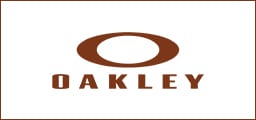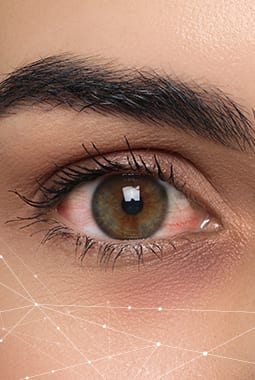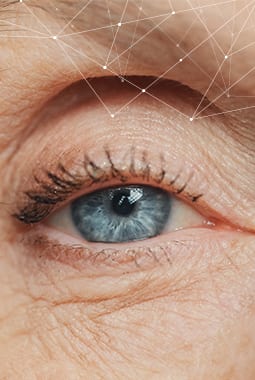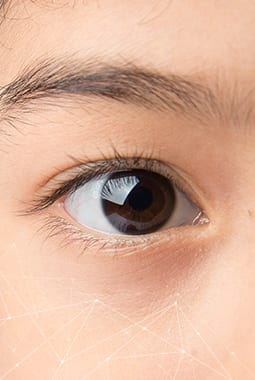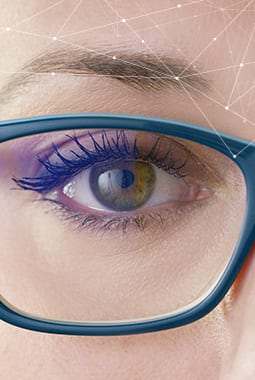

The Importance of Prevention & Early Detection
At Blue Ridge Eye Care Associates, we believe that vision is a precious gift that we’re dedicated to preserving. Eye diseases can significantly affect your vision and overall health. Many of these conditions develop without symptoms and can lead to blindness. That’s why getting routine eye exams are so important! Our goal is to catch these diseases before you ever know they are present and keep it that way. With our routine and thorough advanced care, we can help give you and your family peace of mind.
Identifying & Managing Common Eye Conditions
Even if you think your eyes are healthy, regular eye exams are crucial in detecting potential issues before they lead to permanent vision loss. By examining the whole picture—your visual abilities, eye structures, and overall comfort—we can catch problems in their early stages and help to prevent damage to your vision and eye health.
Age-Related Macular Degeneration (AMD)
Age-related macular degeneration is when the macula begins to thin and deteriorate. It’s the leading cause of severe vision loss in adults over 50.
AMD can be either dry or wet:
- Dry AMD leads to gradual vision loss as protein clumps begin to form, affecting the cells of the macula. Over time, dry AMD can progress into wet AMD.
- Wet AMD is less common but can significantly risk your eye health and vision. This condition involves the growth of abnormal blood vessels beneath the retina, which can leak and scar the macula. If left untreated, wet AMD can result in rapid vision loss.
Cataracts
A cataract is a cloudy spot that forms on the eye’s normally clear lens, affecting your ability to see, read, or even recognize facial expressions. Cataracts can develop slowly over years or rapidly within months. Cataract surgery may be necessary to restore clear vision when vision is severely impacted.
Symptoms of cataracts can include:
- Blurry or foggy vision
- Dull or muted colors
- Difficulty seeing at night
- Light sensitivity
Diabetic Retinopathy
Diabetic retinopathy is a condition caused by high blood sugar levels associated with diabetes. Over time, excessive sugar in your blood can damage the retina, the part of your eye that detects light and sends signals to your brain.
Symptoms can include:
- Blurry vision
- Poor color vision
- Poor night vision
- Floating spots in your vision
- Blank spots or blindness
Glaucoma
Glaucoma is a group of conditions that can damage the optic nerve, which is responsible for transmitting visual information from your eye to your brain. This damage can often be linked to high pressure within the eye, but glaucoma can occur even with normal eye pressure.
Glaucoma can affect people of all ages but is more common in older adults. About 3 million Americans have glaucoma, and it’s the second leading cause of blindness worldwide.
Many forms of glaucoma have no warning signs, and the effect is so gradual that you may not notice a change in vision until the condition is in its later stages.
Detecting & Managing Eye Health
We use various diagnostic technologies to check your eye health during your eye exam. Every exam is customized based on your individual visual and health needs, so we may use a combination of techniques and technologies to get a complete view of your vision.
We genuinely care about your comfort and health. By using detailed imaging and testing, we can help safeguard healthy vision for you and your family throughout every stage of life.
Optical Coherence Tomography (OCT)
With Cirrus HD OCT (optical coherence tomography), we can capture detailed eye scans, which helps us detect and treat retinal diseases. OCT technology has elevated our level of care by providing detailed, microscopic views of ocular structures undetectable with the unaided eye. The analysis software allows us to compare measurements over time and determine if even minor changes have occurred.
Nidek Fundus Camera AFC-230
Fundus photography is an imaging technique that can noninvasively capture details of the back of the eye (the fundus), including the optic nerve, retina, vitreous, and blood vessels. With the Nidek Fundus Camera, we can comprehensively document and monitor changes in eye structures, which is crucial for managing eye conditions like diabetic retinopathy, macular degeneration, and glaucoma.
Optos Daytona Widefield Retinal Imaging
The Optos Daytona is a retinal mapping system that captures a panoramic image of the inside of the eye. With optomap technology, we can capture 82% of the retina in a single scan, whereas traditional retinal images only capture about 15%. The wider, detailed views allow us to monitor conditions that affect the retina and tissue at the back of the eye.
Ocular Response Analyzer
The Ocular Response Analyzer G3 is an instrument used to analyze intraocular pressure (inner eye pressure) without touching the eye. This analysis helps us accurately screen for eye conditions like glaucoma, which is often caused by increased pressure.
We can also evaluate how the eye tolerates changes in eye pressure with corneal hysteresis. The device also includes other forms of tonometry, offering additional options to aid eye pressure measurement.
Adaptdx Dark Adaptometer
The Adaptdx Dark Adaptometer can measure how your eyes adapt to dim lighting or darkness. By evaluating your response, we can detect early signs of macular degeneration, even when imagery has yet to reveal changes to physical structures.
MPOD MPS II
The MPOD MPS II can help reliably and accurately measure macular pigment optical density. This helps us detect changes to your central vision and color vision. The macula is protected by a layer of pigment, which the MPOD MPS II can measure to identify degeneration. When detected early, this protective layer can regenerate with treatments like nutritional supplements.
NIDEK OPD-Scan III
This NIDEK OPD-Scan III is an autorefractor, an instrument that can estimate refractive power, which helps us accurately evaluate a patient’s prescription. The scanner can also create a topographical (3D) map of the cornea (front of the eye) to aid in detecting and monitoring several eye conditions.
Diopsys Nova ERG & VEP
The Diopsys Nova ERG (electroretinogram) and VEP (visual evoked potential) allow us to evaluate how the optic nerve and retina conduct signals. Everything you see is communicated through nerve signals sent from your eye to your brain. By measuring these signals, we can diagnose and treat various conditions, such as glaucoma.
Humphrey Visual Field Analyzer
Your visual field is the complete picture of what your eyes can see without moving–straight ahead (central vision) and the sides (peripheral vision).
The Humphrey Visual Field Analyzer can help us evaluate your visual field quickly and in-depth so we can identify any gaps or blank spots in your vision. Our analyzer is designed to decrease test times, improve accessibility for patients with mobility concerns, and enhance early detection.
Accutome B-Scan
Although used less frequently than other imaging techniques, ultrasound technology can help us measure structures when views inside the eye are obstructed. With the Accutome B-Scan device, we can measure small details, like eye freckles (called nevi) at the back of the eye, to assess if there’s a cancer risk.
Visit Us Today for Comprehensive Eye Care
You deserve vision care that really cares about your needs. We’re here to help you maintain and protect your vision. Even if you don’t think you’re at risk for an eye disease, regular eye exams can give us insight into how to support your everyday vision.
We can offer proactive treatments for your child’s myopia or help improve discomfort with dry eye treatment. Whatever your goals are, we’re here to lend a hand.
Book your eye exam today.
Request AppointmentOur Location
Visit Us
Our building is located at the intersection of East Stuart Drive and Larkspur Lane. We look forward to welcoming you to our practice family.
Our Address
- 800 E Stuart Dr.
- Galax, VA 24333
Contact Information
- Phone: 276-236-4171
- Fax: 276-236-0909
Our Hours
- Monday: 8:00 AM – 5:30 PM
- Tuesday: 8:00 AM – 5:30 PM
- Wednesday: 8:00 AM – 5:30 PM
- Thursday: 8:00 AM – 5:30 PM
- Friday: 8:00 AM – 5:30 PM
- Saturday: Closed
- Sunday: Closed
Our Brands




